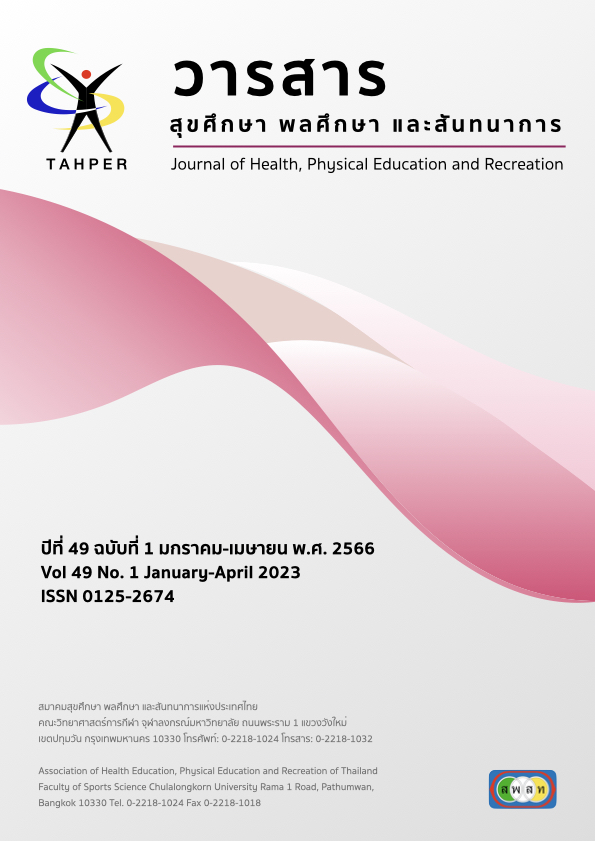A Development of a Traditional Thai Dance Exercise Program to Improve Body Balance in the Elderly
Main Article Content
Abstract
The purpose of this study is to develop a Traditional Thai Dance Exercise Program to Improve Body Balance in the Elderly. The participants are 44 elderly and ages from 60-70 years old all of which is living in the western part of Thailand. The participants were selected through a random multi-stage sampling. They were divided into two groups: the experimental group and the control group. After that, a body balance test is conducted on both groups before beginning the studies. This test was carried out again at the end of weeks 4, 8, 12, and 16. The analyzed data displayed the differences between the experimental group and the control group. By using t-test independent statistics, we can accurately compare the two groups’ results. Three stages in this study include: First, the participants answer questionnaires about their background exercise, and was examined through a physical fitness test. Second, the researcher develops a Traditional Thai dance exercise program. The program then received a quality check by 5 experts in the field of physical education. The third stage the evaluation program exercise.
The research found that; 1) The finding regarding exercise background of the elderly indicates that most of them had high blood pressure. The reason for exercise is to maintain physical fitness. The frequency of exercise is 3-5 day per week and the type of exercise is walking for 31-60 minutes in the morning from 05.00-9.00 am. in a park. This research also reveals that physical fitness of the elderly; upper-body strength, is rated higher than normal while lower-body strength and upper-and-lower body flexibility are rated in the normal range. In addition, aerobic endurance and agility/dynamic balance is rated lower than the normal scale. 2) The traditional Thai dance exercise program revealed the Index of Item-Objective Congruence (IOC) rang between 0.60 – 1.00 3) The result shows that body balances of the elderly in the experimental and the control groups are statistically different at the .05 level.
Article Details

This work is licensed under a Creative Commons Attribution-NonCommercial-NoDerivatives 4.0 International License.
Critical thinking in journals is the right of the author. The Association of Health Education, Physical Education and Recreation of Thailand is not always required, to create diversity in ideas and creativity.
ความคิด ข้อวิพากษ์ในวารสารเป้นสิทธิของผู้เขียน สมาคมสุขศึกษา พลศึกษา และสันทนาการแห่งประเทศไทยไม่จำเป็นต้องเห็นชอบด้วยเสมอไป เพื่อให้เกิดความหลากหลายในความคิดและความสร้างสรรค์
References
เจริญ กระบวนรัตน์. (2562). เอกสารประกอบการอบรม Intensive Senior Fitness Trainer Certification Course “การเสริมสร้างความแข็งแรงผู้สูงอายุ” ครั้งที่ 1. กรุงเทพฯ: ม.ป.พ.
นฤมล สบบง. (2552). ผลของการออกกำลังกายแบบฟ้อนเจิงมช. ต่อความสามารถในการทำหน้าที่ของร่างกายในผู้สูงอายุโรคหลอดเลือดหัวใจ (วิทยาศาสตร์มหาบัณฑิต). เชียงใหม่: มหาวิทยาลัยเชียงใหม่.
เพ็ญพักตร์ หนูผุด. (2560). ผลของรำไทยที่มีต่อความสามารถในการทรงตัวใน ชีวิตประจำวันของผู้สูงอายุ (ปริญญาวิทยาศาสตรดุษฎีบัณฑิต). กรุงเทพฯ: จุฬาลงกรณ์มหาวิทยาลัย.
มณีพรรณ์ เหล่าโพธิ์ศรี และคณะ. (2556). ผลของการรำไทยต่อการทรงตัวในผู้สูงอายุชาวไทย. จุฬาลงกรณ์เวชสาร, 57(3), 345-57.
สำนักงานคณะกรรมการพัฒนาเศรษฐกิจและสังคมแห่งชาติ สำนักนายกรัฐมนตรี. (2556). การคาดประมาณประชากรของประเทศไทย พ.ศ. 2553-2583. กรุงเทพฯ: เดือนตุลา.
ศูนย์การแพทย์กาญจนาภิเษก. (2555). ถอดรหัสการดูแลผู้สูงวัยอย่างบูรณาการ. กรุงเทพฯ: แลงแกวจ เซ็นเตอร์ แอนด์ แอดเวอร์ทิสเมนท์.
ศิริมงคล นาฎยกุล. (2551). นาฎยศิลป์หลักกายวิภาคและการเคลื่อนไหว. กรุงเทพฯ: โอเอส พริ้นติ้ง เฮาส์.
American College of Sports Medicine. (2006). ACSM s guidelines for exercise testing and Prescription (7thed.). Baltimor: Lippincott Willian & Wilkins.
American College of Sports Medicine. (2014). ACSM s guidelines for exercise testing And Prescription. Philadelphia: Wolters Kluwer Health/Lippincott Willian & Wilkins.
Bogle-Thorban L, Newton RA. (1996). Use of the Berg balance test to predict falls in elderly persons. Phys Ther, 15, 576-583.
Carneiro, N. H., Ribeiro, A. S., Nascimento, M. A., Gobbo, L. A., Schoenfeld, B. J., Achour Junior, A., et al. (2015). Effects of different resistance training frequencies on flexibility in older women. Clin Interv Aging, 10, 531-538.
Chang, K. V., Hung, C. Y., Li, C. M., Lin, Y. H., Wang, T. G., Tsai, K. S., et al. (2015). Reduced flexibility associated with metabolic syndrome in community-dwelling elders. PLoS One, 10(1), e0117167.
Costa, T. C., Locks, R. R., Koppe, S., Yamaguti, A. M., Formiga, A., and Gomes, A. (2013). Strength and stretching training and detraining on flexibility of older adults. Top Geriatr Rehabil, 29(2), 142-148.
Granacher, U., Muehlbauer, T., Bridenbaugh, S. A., Wolf, M., Roth, R., Gschwind, Y., ...Kressig, R. W. (2012). Effects of a salsa dance training on balance and strength performance in older adults. Gerontology, 58(4), 305-312.
Sofianidis, G., Hatzitaki, V., Douka, S., & Grouios, G. (2009). Effect of a 10-week traditional dance program on static and dynamic balance control in elderl adults. Journal of aging and physical activity, 17(2), 167-180.
Sue scott. (2008). ABLE Bodies Balance Training, pp 3-14 .United States.
Young, C., Weeks, B., & Beck, B. (2007). Simple, novel physical activity maintains proximal femur bone mineral density, and improves muscle strength and balance in sedentary, postmenopausal Caucasian women. Osteoporosis International, 18(10), 1379-1387.
Williamson, P. (2011). Exercise for special populations. Philadelphia: Wolters Kluwer Health/Lippincott Williams & Wilkins.


